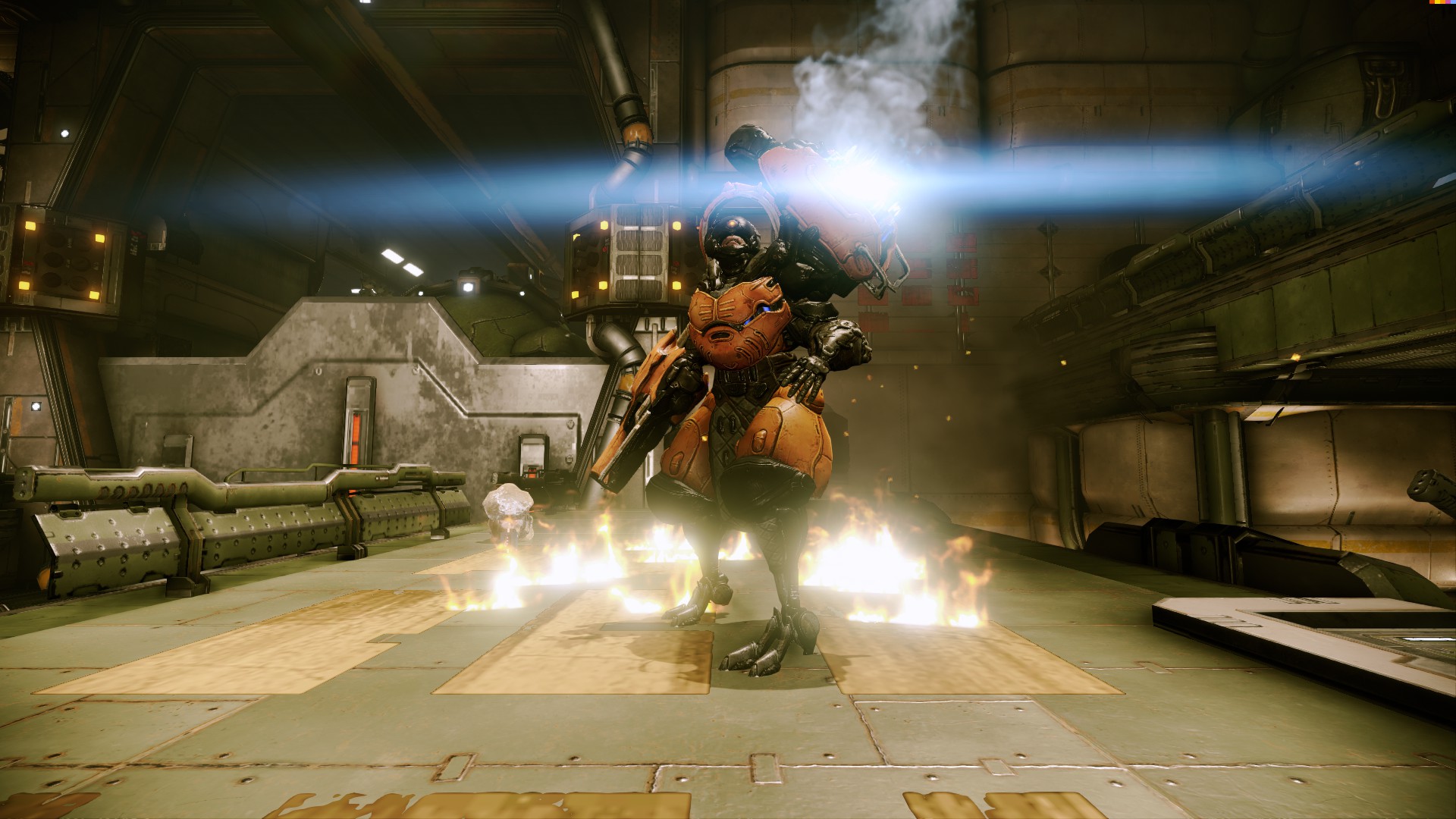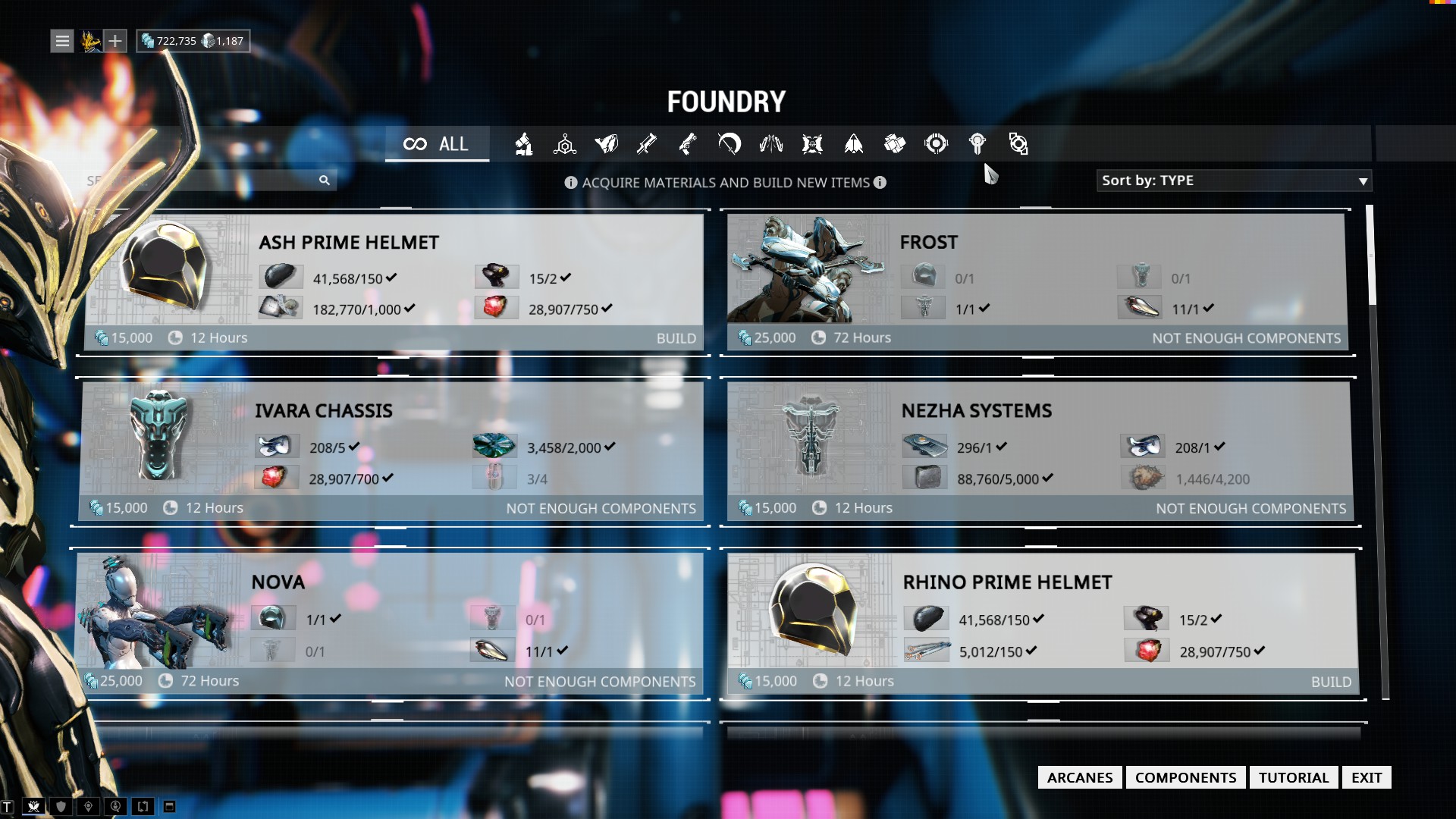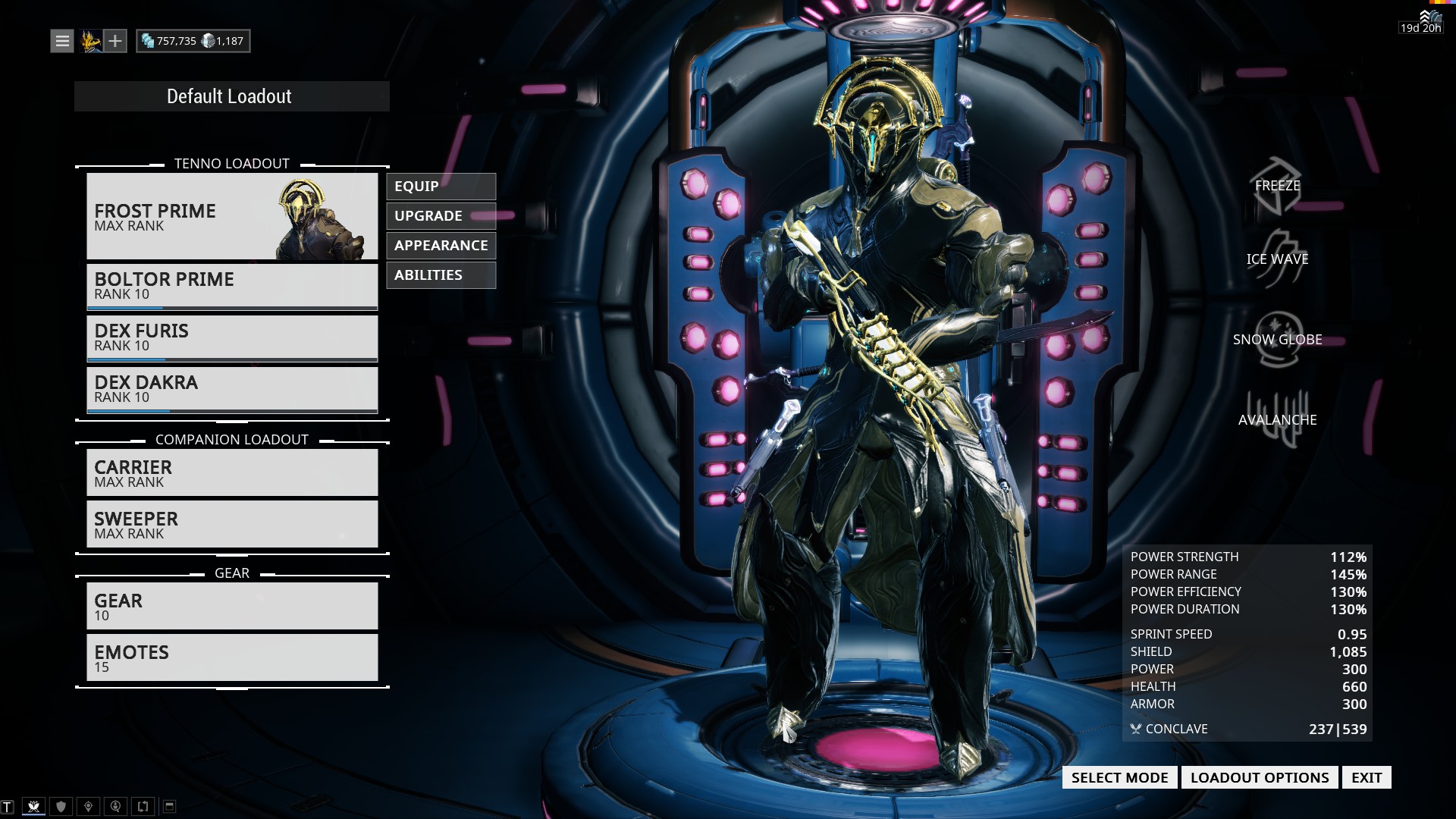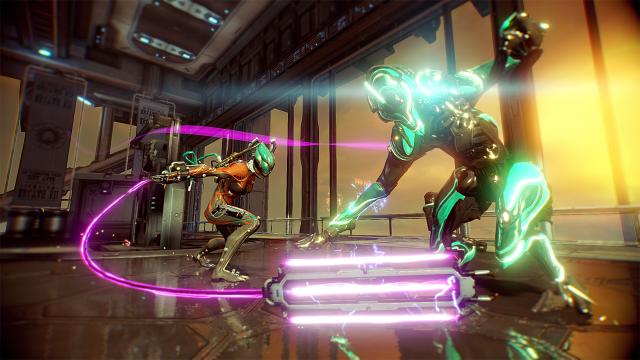In the distant future of Warframe, you are a space ninja who has woken from a long slumber to find the solar system in disarray. Armed with a variety of exciting powers, you must fight an army of decaying clones, tech-minded science jerks, mutant freaks and other awesome enemies. The entire game is free to play, but it’s so good that I spent over a hundred bucks on it and don’t regret a cent.
For me, it’s a point of pride that I don’t spend money on free to play games. Spending money means giving in to systems designed to manipulate me; it feels like losing. That constant reminder on players to buy, buy, buy is like a movie theatre interrupting a movie every few seconds to remind people that they can buy popcorn and soft drinks any time they’d like. Not giving in to the ads feels like winning against an intrusive and unpleasant experience.
Digital Extremes’ Warframe is different — different enough that I actually bought Prime Access and some platinum. In all, I’ve spent about $130 on the game, something I’ve never done for a free to play game before. I felt like Warframe was worth it.
You don’t have to pay, though, and the game does not constantly dangle the option to pay in your face. The only reminders that you should spend money are located deep within customisation menus or in the store, which is a console in your ship that you can easily ignore.
The multiplatform free-to-play game is an action shooter with some of the trappings of an MMO. It launched in 2013 and is available now on PC, PS4 and Xbox One, where it is regularly updated. As a recently-awoken space ninja called a Tenno, your job is to fly around the solar system doing space ninja stuff like assassinations, spying on people, stealing information and performing sabotage. Each mission location and type remains the same, but the missions themselves are somewhat randomised. The game relies on a random tile system to keep things fresh. Your base of operations — and your main menu — is your ship.
When you log in, you’re sitting in front of your command console, which lets you select where you want to go in the solar system. To your right is the store. To your left is the codex. Behind you, deeper in the ship, are other stations, like the foundry that lets you build weapons or the armoury that allows you to outfit and modify your frames.
Ah, right, frames. The eponymous warframes operate like character classes, except instead of being locked into one class per character, you can swap frames at will, with each frame having four unique powers. For one mission, you might feel like running the supportive frame Trinity, who can mass heal the entire team or provide energy vampire abilities to ensure quick regeneration. On the next mission, you might want to play as Ember, whose incredible World on Fire ability burns every enemy within a massive radius.

You obtain warframes by defeating bosses and getting their parts or by completing some of the game’s great quests. Warframes are not just some cool gimmick or branding idea, but a cool design choice. Two good ideas make them great: first, they’re all overpowered, and second, you have to hunt them down.
Warframe doesn’t care about balance. You’re a badarse space ninja, after all! Rather than pushing players through a lengthy and meaningless grind, Warframe provides players tons of awesome and incredibly destructive powers. I love running Frost, a frame that launches a massive blast of ice, freezing everything around it, killing most low-level enemies. Playing like Frost feels like running around as a tactical nuke. The sheer destructive power being wielded is awe-inspiring, but that’s true of every frame. Valkyr’s power is invulnerability. It comes at the expense of ranged weapons, but that’s fine, because as a space ninja, your swords are just as cool, if not cooler, than your guns.
What’s great about being overpowered is that, since everyone is overpowered, no one is. The power you wield makes you feel like you’re actually a badarse space ninja, because you’re killing lots of enemies quickly and efficiently. Other sci-fi games, like Mass Effect 2, force you into cover through a lack of health and a focus on small groups of enemies. There’s no sense of lethality or badarsery going on when your character feels like they’re made of soggy toilet paper while enemies can last through an entire magazine of gunfire. Warframe understands this, so every frame feels fun to play, because every frame has powerful, over-the-top capabilities.
A friend of mine recently picked up one of the harder-to-obtain warframes, Ivara. He didn’t like her at first, until he realised that, among other things, he could use her abilities to create ziplines anywhere on the map. Ivara drastically altered his mobility and our fireteam’s damage capabilities, allowing us to breeze through content that had previously been too challenging.

I’ve played a lot of games over the years, and it seems like most developers’ idea of balance is that everything should feel equally underpowered. The player generally has to play with caution, staying back, even occasionally bunching up, letting enemies come to them as they cheese their way through fights. Warframe‘s “you should feel like a ninja” approach encourages more proactive players who slice, dice and explode their way through hundreds of enemies. I’ve seen builds that kill every enemy on the field at a given time. I’ve watched players one-hit kill a boss and continue onwards as if nothing happened. Warframe’s lethality doesn’t just make you feel effective. It gets you through content quickly, too.
Most online games require massive amounts of player time but lack sufficient content to actually demand that time. They rely on heavy amounts of repetition and luck. Players have to play a lot to get a little. Warframe instead allows you to pass through content quickly and always guarantees something interesting at the end of the journey.
As a ninja, you can “bullet jump” through most of the maps. Bullet jumping is a way to bypass lots of enemies by zipping past most enemies faster than they can respond. This means that you can get through missions quickly. That works well with another of the game’s better-implemented elements: timed content. Every few minutes, a new challenge pops up. Sometimes, the reward is credits. Other times, it’s crafting materials. I follow a Twitter feed that alerts me any time a blueprint is available. Combined with the speed at which I can complete content, I can catch a Twitter alert, pop into the game, grab the loot I want and get back to whatever I was doing without a problem.
I recently got an alert for an item I wanted, logged in, played through the mission and obtained the item within about 10 minutes. The result is a game that can be played in brief 10 to 15 minute spurts, as opposed to a game like The Division, which has a tiny handful of missions that require daily grinding if you want to be able to get enough credits to buy good gear.
Warframe’s speed means that it doesn’t doesn’t demand your commitment, but if you’re looking for something more in your relationship, the game’s got you covered.
A traditional loot game sends you into an encounter with the expectation of randomised loot. Take Borderlands, for instance. The game claims to have about 87 bazillion guns, but how many of those are meaningful or interesting guns? Most of the guns I’ve encountered in the Borderlands series are samey, even unremarkable, with the exception of a few gag guns. The same is true of The Division; I can’t tell you how many Vectors I’ve located, but I can tell you that they all play the same, just doing more or less damage depending on their stats.
Warframe isn’t like that. Rather than having levelled loot with the traditional white/green/blue/purple/orange colour scheme, Warframe has a distinct selection of unique gear. The Atlas frame plays differently than Mesa, who is completely unlike Zephyr, who is nothing at all like Ash. The guns are distinct, too. A player running a grenade launcher like the Tonkor is going to be playing very differently than a sniper using Amprex Vulkar. I’m hoping to obtain a Sancti Tigris soon.
Because all the loot is specific, play feels a lot more organised. Rather than simply flinging one’s self at a boss in the hopes of getting good loot, Warframe players plan a specific route to good gear. If I want to obtain the Equinox frame, for instance, I need to face Tyl Regor, the final boss on Uranus. Fight him enough and he’ll drop all the gear I need.
Bosses will always drop an important component or blueprint. The majority of frames only need three parts: the systems, chassis and helmet. To get those parts, players need blueprints. Face a boss down five or six times, and you’ll probably get all of them. Make sure you have the crafting materials you need, stick the parts in the foundry, and you’re all good to go. In a few days, you’ll have an entirely new way to play the game.
Because bosses always drop good loot, it feels like you’re always progressing. There’s rarely a shout of disappointment when members of my clan face a boss in Warframe. Even when the boss drops a part we already have, we can sell it for resources. There’s never a situation where you’re fuming because you’ve just spent an hour on a mission and the boss only dropped loot that was below your level. Warframe bosses always drop something useful.
You almost always have something to do. Want to craft this frame? Cool, hunt down that boss. Oh, need some certain materials to build those parts? Let’s go to this location and get some materials. But wait! There’s an alert for something you need. Better do that really quick. There’s always something to do if you want, always something to find and benefit from.
There’s no such thing as getting a gun that’s below your level, because all guns — and all frames — are created equal. Everything is overpowered, and everything is easily obtained. Warframe never wastes your time with extremely long missions with bad drops. There is no room for disappointment. It’s a game about momentum.
That’s Warframe in a nutshell. It’s a game that lets you feel like a badarse by giving you tremendous amounts of control over the way you play. Want to spend 10 minutes with the game? Have at it. Want to use a completely different class? Why not! Most games let you create one character — a Hunter or a Soldier or a Witch Doctor or what have you, and you’re locked into that. If you want more characters, you have to replay the entire story and level up a new character from scratch. Warframe is better: it provides you with the ability to unlock up to 29 different classes with four abilities each and switch between them at will. Plus it has an extensive modding system that allows you to radically customise your characters and weapon loadouts.

The most recent major addition to the game is Update 18.5, which adds a new major quest line, a new tileset and a new warframe, Inaros. The big updates seem to arrive every few months — the PC version of the game gets hotfixes and updates almost every day. The last major quest update, The Second Dream, Update 18.0, launched 3 December 2015.
Digital Extremes does an excellent job of updates. Heck, they will warn you in-game that they’re pushing an update, unlike many games I’ve played, that randomly force players out without a word. Digital Extremes isn’t afraid of massive changes, either. Back when I first started the game, there was no spaceship and everything was done in menus. Now we’ve got more planets, several massive quests, the ship, and some other very good new features that I’d rather not spoil.
It’s a counterintuitive game: rather than increasing the length of its grind, Warframe has shortened it to digestible amounts. Rather than constantly reminding me it has items available for sale, Warframe has quietly nudged me whenever it has one of its frequent updates. Instead of providing small, single-digit per cent chance upgrades, for a character with a single powerful ability, Warframe has created a massive variety of extremely different playstyles and emphasised constantly switching those up.
I wish more games were like Warframe. I like being able to jump in for a few minutes and feel like I progressed just as much as I like to log on for a few hours and feel like I did a lot of different things. I love being able to pick specific loot and make concrete progress towards that. I love how all my abilities seem different and interesting. I use a combination of my abilities, mods, weapons and my friends’ abilities to have a good time.
Warframe has its problems, sure. I felt more like a ninja in Metal Gear Rising. The enemies were more fun to fight in Gears of War. The guns are a lot more satisfying in Halo. As persistent online games go, however I think it’s the best one out there right now. It’s free, and it’s available on just about every major gaming platform out there. Definitely give it a try.

Comments
9 responses to “It’s 2016 And Warframe Is Still An Excellent Free-To-Play Game”
I am a fan of the game as it has so much depth but get a little pissed at the 3rd person controls. They are just that little bit clunky for me and much prefer a FPS… There are obviously some tricks to progressing as I’ve hit a bit of a wall and I figure the game is simply tempting me to buy something. Nothing wrong with that, but can be hard to work out what to do next to actually progress.
No mention of the biggest grind, the void?
Grinding for prime pieces is one of the biggest time sinks for this game, and running the same 20 minute survival mission 30+ times to try and get the piece I want isn’t much fun (not to mention grinding for the keys required to even run the mission).
Like any game with RNG, sometimes it’s a bitch. Yes, most of the warframes only require three parts, which doesn’t sound so bad, but I still had to fight Lech Kril about 40 times before he dropped the Frost Systems.
Warframe is a fantastic example of how a free to play game can work without being intrusive (I have pretty much everything and haven’t spent a cent), but it most certainly does have a similar RNG grind to many other games.
I have been playing Warframe a long time nearly 3 years now, on and off of course. I feel the only thing the game makes me play for is inventory space which I have no problem in paying for with this game at least and them colour palettes I gotta look pretty.
The thing about Warframe is the progression in the game is what you want out of it. You make a goal of what you want to play as in the game or what to be recognized as a player and you make it happen,
For instance a player like me has to try every character to see how I can make certain builds work like a damage buffer Banshee, Rhino, Nova, etc. Also to find out what my teammates abilities do and how I can work with that when I come across someone playing that warframe.
From what I see from most players a good chunk want to get best in slot/mandatory mods like serration and some prime mods maxed or to a level they are comfortable with by grinding higher level areas for them sweet rare 5 fusion cores.
Then you have the dedicated traders which farm the void which is where you get prime parts for prime weapons and warframes and sell them to other players with the paid currency platinum which everyone calls plat.
There is also a bunch of people that care about mastery rank and that is their sole purpose for playing to have the highest rank which I think is currently 21 which you get from maxing gear.
I hopped off the mastery train a while back, I’m mastery rank 17 and if anyone decides to play the game on PC you might see me hovering around the new player planets as I tend to help new players get the grasp on where to find resources for crafting and just answering their questions on the game.
This is from the article…..
There’s no such thing as getting a gun that’s below your level, because all guns — and all frames — are created equal. Everything is overpowered, and everything is easily obtained. Warframe never wastes your time with extremely long missions with bad drops. There is no room for disappointment. It’s a game about momentum.
AHAHAHHAHAHAHAHAHAHAHAHAHAHAHAHAHAHAHAHA!!!!!!
Come back to me when you have 800 hours in the game.
Well, arguably there is little point in making a Lato or Vasto too overpowered as there is a cap on their damage that is undeniably lower than that of a Lex (tbh a maxed Lato doesn’t even hit the base damage of a Lex Prime) so there is little reason to 36 Forma those, but most, in particular Trinity, can get very high. There isn’t much of a point to fight enemies past level 123 though.
super hard to find any thing on how upgrade your gear to the level you at, i still have no idea, i cant beat any NPC at my level even with the upgrades ive found, cant ptogress.
I’ve played a little of Warframe, only around 15 hours, and enjoyed my time with it, but i’m still stuck with the frame I chose and THE GUN I STARTED WITH.
To me this is slightly punishing for early game, there’s not really a chance to try any other weapon type early on without spending money. Personally I just wish it was a paid game, I would have happily given them my $80 plus whatever each expansion costs but I just couldn’t push through that initial grind with no change in weapons or playstyle, it became too repetitive.
It’s unfortunate because the base gameplay is actually a lot of fun (SPACE NINJAS. Space. Ninjas.) i’m sure if I gave it a bit more time and got to know the systems better i’d enjoy it but… I just couldn’t help but feel the opposite of what you describe, I just wish i’d paid for the game up front and be done with it.
Either that or they introduce some weapon variety for early missions. Seems like a big barrier to entry to me.
Those of you who have played a lot, have I missed something basic?
I know it can be hard to remember early game once you pass the 500 odd hour mark but any thoughts…?
Hey morph,
go to the shop in your Liset and buy blueprints for some new weapons using the credits you’ve already earned. Then it’s about finding all the parts needed to make that weapon (as well as another batch of credits to set the foundry in motion).
New weapons, suits and everything is a never-ending chase for resources, credits and blueprints. You’ll receive some parts from missions but most of my starting gear I bought the blueprint outright then farmed the parts.
Also, read up on where to get new frames from. These will spawn from particular missions or bosses so it’s about beating them over and over again to farm out the blueprints so that you can then make the parts in the foundry.
Also, don’t neglect on mods! And don’t auto-apply your mods! Take the time to understand what damage types will be more useful… so if you’re farming a warframe or weapon blueprint and it’s a Grineer mission, you’d focus on the types of damage that would have more effect on the Grineer (don’t ask me what that is, i’d normally have to wiki it!).
Ah nice one thanks for that!!
I have vague memories of the store, it was all a bit overwhelming from memory, and I had no idea how any of the weapons or anything played so was a bit… unsure of what to buy.
I did love the mods though 🙂 OMG so many options, heavenly. (or hell-ly depending on your disposition I guess)
I might try and jump back in at some point, and bring some people with me, although with the whole Souls thing happening tomorrow it might be a while…
Thanks again!
When first starting out, try burning through up to Saturn then start buying Blueprints in the market. A majority of the actually GOOD gear requires to to beat the star chart (or at least unlock each planet) and by then that is when the game becomes a grind. For now, grind that star chart and get AS MANY mods as possible as discarding mods is the greatest regret you’ll have in the long run. I can’t tell you how many SUPER rare mods I’ve casted out as a noob because I didn’t understand. As a noob, the best Sword is probably Dual Heat Sword and the best Primary is a Cernos- if you are good at aiming.
Well, tbh not all gear is OP. But it depends on what you refer to as OP. When I first started playing (3-4 years ago?) I thought level 20 was pretty strong and modded my gear to what I thought was “OP”
Well, now I am fighting level 40’s and melting through them like butter with an Orthos Prime (speedy staff weapon) and even scaling my Katana up to fight enemies at level 120. Apparently, 156,000 damage (what my Nikana does) isn’t “OP” either. Only a few things, very surprisingly are “OP”. One, being Trinity, who’s Energy Vampire ability can Leech off BILLIONS of damage (the cap being only slightly higher) and Excalibur’s Exaulted Blade (which isn’t that OP anymore. Thx. Nerf)
My point is that many things can be OP, but aren’t because being impressed your Lex can do 10K damage will only get you laughed at.
Oh, and we should expect an overpowered potato canon any day now. Idk what the obsession is with potatoes but there is one.